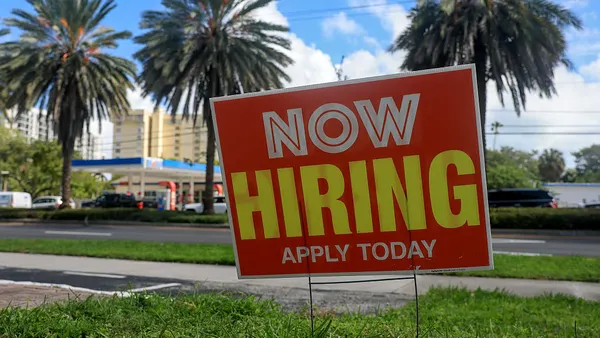Editor's note: This article is part of The Water Cooler, a recurring column for technology executives to digest, discuss and debate. Next up: What is your technology strategy to support hybrid work? Email us here.
What it means to be a CIO today has evolved since the role first sprung up four decades ago.
As the technology changes, so do the technical requirements, but the role has gained a larger business component over the last three to five years as CIOs branch out to become strategic advisors.
While CIOs were originally intended to evolve from the chief operating officer role, motivations and skills behind becoming a CIO vary between executives. For a glimpse into how and why professionals become CIOs, CIO Dive asked eight executives about their journey to the C-suite role
(The comments below have been lightly edited for length and clarity.)
Michael Voegele, chief digital officer and CIO at Philip Morris International
"Nothing has helped my career more than being open, transparent, and straightforward with everyone with whom I work."

Michael Voegele
Chief digital officer and CIO at Philip Morris International
Technology has been a part of my core for as long as I can remember. As a child, I was constantly exploring and tinkering with things to figure out how they worked — not always with happy results.
By 10th grade, I had realized technology was the path I would follow in my career, and so I transferred to a specialist science and technology school. It never occurred to me that I would become a CIO, though. I was just a person who raised his hand when the opportunity arose in hopes that I could use the position to steer and shape the organization for the better.
I have never considered myself purely a "techie." I am interested in how technology can benefit business and society, which is why I pursued a joint technology and business degree at university. And I will always be more interested in the people who use the technology than in the technology itself.
One of the reasons I began my career at SAP was that they promised to invest heavily in the development of their employees. I do the same as CIO. It's important to me to help people progress in their careers, and I try to empower everyone on my team to have the confidence to speak up and offer contrary opinions. Diversity — of people and ideas — is what keeps an organization fresh. It's how we continue to innovate and advance.
My unofficial motto: WYSIWYG (what you see is what you get). Nothing has helped my career more than being open, transparent, and straightforward with everyone with whom I work.
Jennifer Solmi, CIO at Hyer
"I prefer to start with the problem and figure out how to best use technology to find creative solutions."

Jennifer Solmi
CIO at Hyer
My journey to becoming a CIO has been somewhat traditional, although in the end, I would not characterize myself as a "traditional" CIO. The reason I say this is, simply put, technology alone does not really interest me all that much. What really excites me is solving business problems, and if you do this only through the lens of technology, then you may not get the right answers. I prefer to start with the problem and figure out how to best use technology to find creative solutions. ....
After my time at Ernst & Young [in their SAP practice], I ventured out on my own. I worked as an independent SAP consultant for several years, focusing in supply chain. During this time, I walked shop floors and implemented SAP in several cities in both the U.S. and Italy. With safety goggles and a hard hat in place, I learned the absolute importance of paying attention to every single detail, being reminded daily by a supply chain guy in one of the chemical plants that, "If I screw up the data conversion of the bill of material quantities, then I would blow the entire plant off the map." Thankfully this didn't happen.
My last role before becoming CIO and the one that held the answer to my lifelong question — was my 15-year tenure at PepsiCo where I saw the inner workings of a company I truly admired. During my time there, I was responsible for overseeing the sales and go-to-market IT systems for Pepsi North America Beverages — which spanned 35,000 users across US and Canada. It was there I met and worked alongside great people who helped me realize what I wanted to do when I grew up. The answer was that I wanted to work with a unique and amazing team to help start a company, and to solve a looming problem [of labor].
Rohan Amin, CIO of Consumer & Community Banking at JPMorgan Chase
"I made quite a pivot from running cybersecurity for the bank globally to leading all consumer retail facing technology."

Rohan Amin
CIO of Consumer & Community Banking at JPMorgan Chase
I've been at the firm for more than six and a half years now. I actually started out in the firm as the global chief information security officer so I was responsible for the bank's cybersecurity globally. Then, two and a half years ago, I got an opportunity to run retail tech.
It's an example of how the firm promotes internal talent, how the firm thinks about diverse talent and advancing them and supporting them in their careers. I made quite a pivot from running cybersecurity for the bank globally to leading all consumer retail-facing technology.
Being the global CISO and then coming over to being a CIO has been fantastic. Job one for us as we think about customers is always protecting their information and we know that the trust in the brand that people and the customers have.
Having that background certainly helps me in the new role — along with thinking about how we innovate and bring products to market faster — but always knowing that job one is to keep our customers and their information safe.
Stephen Franchetti, CIO at Samsara
"More and more, the technology strategy of a company is becoming the business strategy — and at the center of that is the CIO."

Stephen Franchetti
CIO at Samsara
I've always been interested in technology, but originally I saw myself taking the path of a software engineer. There are a lot of parallels between the role of CIO and engineer, which I soon discovered.
Whereas software engineering is developing technology for customers, the role of the CIO is internal systems engineering to support the scaling of a company.
I grew up in Scotland and moved to Silicon Valley on what I thought was going to be a three-month tech consulting job. Twenty years later and I'm still here — which is a testament to how fascinating this sector is. My first large role was at Cisco, where I spent over 12 years. Helping Cisco grow from 15,000 to 70,000 employees taught me a lot about data architecture and building processes and systems for scale.
I wanted to get back to company-building mode, though, which is why I decided to join Workday (at the time 1,000 people) to lead enterprise applications. One of those applications was Slack. It was being adopted internally at a pace I hadn't seen before. So when they reached out asking if I'd be willing to do a coffee chat and share best practices, I said yes. Months later, I joined Slack as their CIO.
These coffee chats are very common within the CIO and head of IT realm. There's a real affinity between peers because companies are all going through the same challenges. A coffee chat is also how I joined Samsara as CIO, where I am now.
Anthony Macciola, CIO at ABBYY
"You can gain tremendous insight if you take the time to listen."

Anthony Macciola
CIO at ABBYY
I attribute most of my success to having a technical background but being externally-focused — which means listening. Turns out listening is an acquired skill. Most people like to talk instead of listening and ask questions. You can gain tremendous insight if you take the time to listen and learn what your customers are doing and what's going on in the market.
As a C-level exec, I spend more than 70% of my time in the field with sales talking to and listening to customers and have the opportunity to participate in 150 to 200 external discussions a year. The engagements allow me to be the true "voice of the customer" or "voice of the market."
I've also come to realize that my critical thinking and analysis skills are pretty good and somewhat uncommon to find in someone in my position. You put all that together and it results in the ability to identify opportunities and trends and articulate vision, strategy, and technology direction. That's afforded me the opportunity to birth over a dozen v1.0 products, and over 50 distinct patents supporting technology direction.
Deb Gildersleeve, CIO at Quickbase
"Being able to collaborate, think strategically about the business bottom-line and leading with empathy have all really helped me develop my IT leadership style."

Deb Gildersleeve
CIO at Quickbase
Interestingly, I didn't always know I wanted to work in IT. Growing up, my favorite subjects were science and math, but I wasn't sure what that translated to in terms of a career until I started my first co-op in college in an IT department. From that point on, it was clear my career would be in IT. After receiving my masters in Information Systems from Northeastern, I started my career in consulting and did that for about nine years. Consulting was a great starting point for my career and allowed me to build leadership, IT and business skills across a number of different teams, technologies and organizations.
I then worked in IT leadership at Gartner for nearly 12 years, which really set the foundation for where I'm at now. Looking back, a big thing that set me apart from my peers and helped me get to where I am today is my focus on business skills. Being able to collaborate, think strategically about the business bottom-line and leading with empathy have all really helped me develop my IT leadership style.
A big thing that makes IT leaders successful is when they can integrate and collaborate with the rest of the business to solve problems. IT is often seen as a siloed entity, and they should most definitely have a seat at the table for most strategic decisions.
Carter Busse, CIO at Workato
"You need to learn every part of the business so you can understand your team's value-add and where you could be filling the white space."

Carter Busse
CIO at Workato
I've spent years in the IT world doing every job from call center setup to serving as Salesforce's first Salesforce admin. Working at Salesforce as a manager is actually where my ascension to the C-suite started. As the years went on, I started to see my friends in sales and engineering rise through the ranks, receive new titles, and grow their internal visibility, and I started to wonder why I wasn't yet following the same path. I was focused, led a great team, and ran a great operation.
What I realized is that my focus on streamlining our IT operations was too reactive. Instead of moving my career forward, that work was pigeon-holing me as a "fixer" instead of a leader and contributor. That's a common spot to get into, especially in a culture that tells you you'll be rewarded for keeping your head down and being good at your job. I came to see it's about going beyond the traditional functions of IT to provide measurable value for the business — and actively messaging that value internally.
You need to learn every part of the business so you can understand your team's value-add and where you could be filling the white space. It's about developing relationships with business leaders, collaborating on processes, selling your team, and cultivating buy-in and support from all levels of the organization. That's the essential component I was missing early on in my career: moving from "keep the lights on" to "own and message the business value."
Elizabeth Hackenson, Chief Information Officer, Schneider Electric
"I learned the only way to advance was to have the time to be more strategic."

Elizabeth Hackenson
CIO at Schneider Electric
There are many paths to becoming a CIO. In my case, it started with a focus on technology – and then morphed into broad and wide-reaching business transformations. As I think back on my career, my learnings in the first 20 years were fundamental to becoming a CIO.
I never stayed in the same role for more than 24 months, as I always wanted to learn more and accomplish more. I always volunteered for the project people didn't want to join, because of lack of experience and/or the project didn't have a good reputation. For me, these were the perfect projects to learn more, to challenge myself, and to be part of a team to turn the project around.
Later in my career, I found myself in situations where companies were struggling to navigate the internet bust in the early 2000's. Many companies were in distress and required restructuring. I had been a senior leader of a restructuring project, which when successfully completed, gave me the opportunity to move into the CIO role. From there, I took the challenge of integrating two merging giant telecom providers, with a spend of over $1B in IT. Both experiences taught me the importance of speed over perfection — and how to inspire and motivate teams during incredibly stressful times.
One lesson to share: if you want to become a CIO or move into management positions, you must learn to let go. I built my career on technical knowledge, so letting go of being the expert technologist was difficult. However, I learned the only way to advance was to have the time to be more strategic and to let go of what had helped me become a CIO. I had to learn to trust more and to let people make mistakes — to let them experience failure, just like my leaders had let me — although at the time, I didn't know that.






















